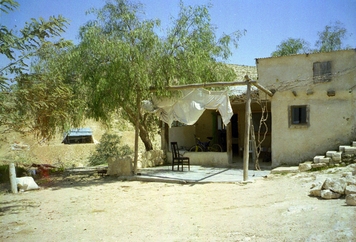
A view of Lakiya, Nagab. Photo: R. Sayigh
|

A view of Lakiya, Nagab. Photo: R. Sayigh |
| Return to 'Israel'/'Palestine', March 2000: |
|
This time I have a plan to begin with the Nagab, and all the necessary contacts for getting there have been made. I spend two days in Jerusalem seeing friends, then leave at 8am on Monday March 27 with Yara and Rasha, two Oxfam workers who are driving to Lakiya, the largest surviving bedouin village in the Nagab. We arrive around midday and visit an adult literacy class for women. Then I go on up to the highest part of Lakiya, to find Sunbala, the weaving project and home of Hassan and Ros Sanaa.
Before marrying Hassan, Ros was with the Red Crescent in Beirut during the Israeli invasion of 1982. We had met briefly. Now she is running a women's cooperative producing bedouin kalims of great beauty, using natural dyes. I hope to stay with them for a few nights, and to benefit from Hassan's knowledge of the area. Everything about my stay in Lakiya is enjoyable. The weaving workshop is a treasure store of the art of the kalim. Ros takes me through each part of the process, from the great vats of dye and mounds of raw sheeps' wool to the piles of kalims, stamped and priced, waiting for sale. I record Ros's story of how the project started and how it's run, not on a factory system but as a cooperative, with women workers producing the kalims at home, and getting paid on delivery. I hope one day to find the time to publish this in a craft journal. The family home, designed and built by Hassan and Ros with help from fellow villagers, is simple but comfortable, insulated by roof design against the harsh sun. A small but expanding garden surrounds it, with a tented yard as extra sitting space. The three children, all in school, spend a lot of time studying; the television is seldom switched on. Since Ros's work with the weaving project is wickedly time-consuming (she takes orders, does accounts, supervises production, drives the van when there are exhibitions, and deals with NGO inspections), any present adult cooks. Hassan also has his project, a village league with both practical and political advocacy aims. Hassan is my guide to Laqiya's history. |
He is distantly related to Tayeb Sanaa, a member of the Knesset, whose imposing villa dominates Lakiya's rambling sky-line. The size and positioning of the villas on Lakiya's central hill is an exact indication of their owners' place in the wealth/status hierarchy. People of the Sanaa 'tribe' are extremely proud of their village and its historic well, known since ancient times as a convergence of trade routes. In 1952 the Israelis expelled Lakiya's inhabitants to Tell Arad, from where they had expelled the Jahileen. Later Lakiya was recognized as a 'legitimate' bedouin township and people were allowed to return. Most of the residents are still from the Sanaa family, but there's a new section now composed of 'outsiders'. An indication of a better than average income level is the number of brick houses under construction, replacing older structures of wood, tarpaulin, and corrugated iron. But infrastructure -- roads, water and electricity supplies, street lighting - is almost as bad as in the 'unrecognized villages'; social services are inadequate: in spite of its size Lakiya has only two primary schools and no secondary one. There is one small clinic.
An Israeli helicopter hovers over us in the clear blue sky the first day while I'm exploring the weaving project. Ros laughs. "We are 'illegal' - the workshop and the house. We built outside the edge of the authorized zone. They could pull us down any time". Hassan later takes me to visit a near neighbour whose home is also 'illegal'. His house is a large structure made of tarred plastic sheets stretched over a wood frame. The floor is earth. There's a pit for brewing coffee, a coffee pounder, and an old army ammo box filled with coffee beans and cardamon. Almost the only furniture is a large TV. We sit and drink coffee and talk. The man says he used to own land in Lakiya but doesn't have a 'tabu' (ownership document). When I reach for my notebook, the man says, No, he doesn't want his name written down or anything he says. He repeats over and over, "I want to live". I'm sad that Leena couldn't join me on this trip - she would have loved the Nagab. But she's hard at work on her thesis, a study of modern photography. |
[The Women's club] [Hajji Mariam al-Sanaa] Copyright©2005 |
|